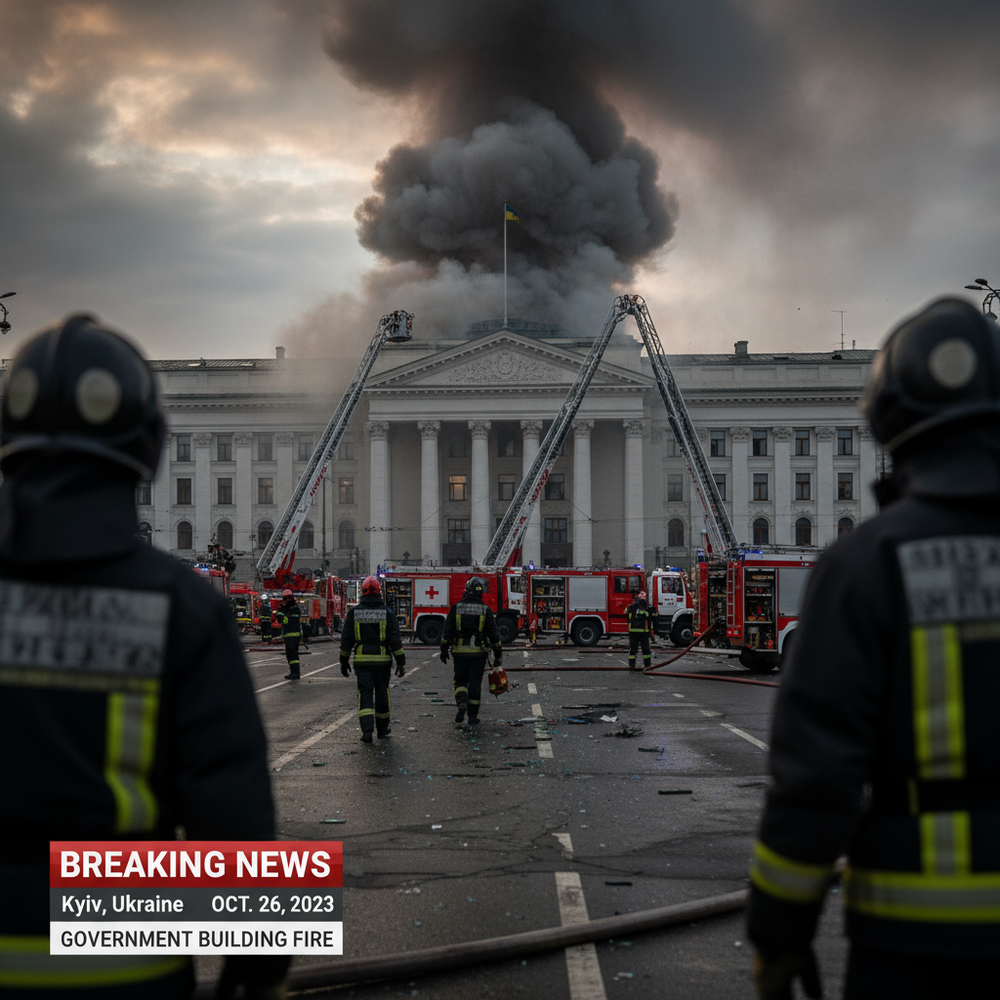KYIV, UKRAINE – In a dramatic escalation of the ongoing conflict, Russia launched its largest air attack of the war on Ukraine on September 7, 2025, deploying 810 drones and 13 missiles in an overnight assault that struck Ukraine’s Cabinet of Ministers building in Kyiv for the first time since the war began. The unprecedented attack killed at least four people and injured 18 in the capital, marking a significant escalation in Russia’s targeting of Ukrainian government infrastructure.
The massive assault, which Ukrainian officials described as the most extensive aerial bombardment since the conflict began, set fire to the main government building’s roof and caused significant structural damage. Ukrainian Prime Minister Yulia Svyrydenko confirmed this was the first time the cabinet building had been directly targeted, calling it a “ruthless attack” on Ukraine’s democratic institutions.
Emergency services worked through the morning to extinguish fires that engulfed portions of the historic government building, while debris from intercepted missiles and drones littered the streets of central Kyiv. The attack demonstrated Russia’s continued capability to launch large-scale operations despite ongoing international sanctions and sustained military pressure from Ukrainian forces.
Unprecedented Scale of Assault
According to Ukraine’s Air Force Command, the September 7 attack involved a coordinated deployment of 810 drones and decoys alongside 13 ballistic and cruise missiles, representing the largest single aerial assault since Russia’s invasion began. The attack targeted multiple regions across Ukraine, with the capital bearing the brunt of the offensive.
“This attack on our government building represents a direct assault on Ukrainian democracy and our sovereignty. We will not be deterred from our path toward freedom.” – Ukrainian President Volodymyr Zelensky
The timing of the assault appears strategically calculated, coming as international attention has shifted to other global issues and as Ukraine continues to press for additional military aid from Western allies. The attack on the Cabinet of Ministers building, which houses Ukraine’s executive branch, represents a clear escalation in Russia’s targeting strategy.
Ukrainian air defense systems managed to intercept a significant portion of the incoming threats, but the sheer volume of the attack overwhelmed defensive capabilities in some areas. Explosions were reported across Kyiv, with residents taking shelter in metro stations and underground facilities as air raid sirens wailed throughout the night.
International Response and Condemnation
The international community responded swiftly to condemn the attack, with the United States leading calls for additional sanctions against Russia. Secretary of State Antony Blinken called the assault “an unconscionable escalation” and reaffirmed American support for Ukraine’s defense capabilities.
European Union leaders convened an emergency session to discuss the attack’s implications, with European Commission President Ursula von der Leyen describing it as “a direct attack on the foundations of democratic governance.” The European Union is expected to announce additional military aid packages for Ukraine in the coming days.
NATO Secretary-General Jens Stoltenberg condemned the attack as a “blatant violation of international law” and announced that the alliance would expedite the delivery of air defense systems to Ukraine. The attack has renewed discussions about providing Ukraine with longer-range weapons systems capable of striking targets deep within Russian territory.
“Russia’s targeting of civilian government infrastructure demonstrates their complete disregard for international humanitarian law. The international community must respond with decisive action.” – NATO Secretary-General Jens Stoltenberg
Strategic Implications
Military analysts view the attack as a significant escalation in Russia’s strategy, moving from primarily military and infrastructure targets to directly targeting the symbols and institutions of Ukrainian governance. The assault on the Cabinet building represents an attempt to undermine Ukraine’s governmental capacity and send a message to international supporters.
The attack comes at a critical juncture in the conflict, as Ukraine has been making territorial gains in several regions and international support has remained strong despite the prolonged nature of the war. Russia’s decision to launch such a massive assault may indicate growing desperation as military objectives remain unmet.
Defense experts note that the scale of the attack required significant planning and resource allocation, suggesting that Russia retains substantial offensive capabilities despite reports of equipment shortages and personnel challenges. The use of 810 drones represents one of the largest drone swarm attacks in modern warfare history.
The targeting of government buildings also raises concerns about potential future attacks on other critical infrastructure, including power plants, water treatment facilities, and transportation hubs. Ukrainian officials have placed all critical infrastructure on high alert following the attack.
Humanitarian Impact
Beyond the immediate casualties, the attack has had a profound psychological impact on Kyiv’s civilian population. Many residents reported feeling that nowhere in the capital was safe, as the government district had previously been considered one of the most secure areas of the city.
Local hospitals treated 18 injured civilians, with several in critical condition from debris and blast injuries. The attack occurred during early morning hours when government buildings were largely empty, potentially preventing a much higher casualty count.
Emergency services praised the effectiveness of Ukraine’s early warning systems, which provided residents with sufficient time to seek shelter. However, the attack highlighted the ongoing vulnerability of civilian areas to Russian aerial assaults.
The psychological warfare aspect of targeting the seat of government was not lost on Ukrainian officials, who emphasized that such attacks only strengthen their resolve to resist Russian aggression. President Zelensky made a point of conducting his daily address from the damaged government building to demonstrate continued functionality.
Military Analysis
The September 7 attack represents a significant tactical shift in Russia’s approach to the conflict. Previous large-scale aerial assaults had primarily focused on military installations, power infrastructure, and industrial facilities. The direct targeting of government buildings indicates a strategy aimed at disrupting Ukraine’s command and control capabilities.
Military experts note that the attack’s timing coincided with several important diplomatic meetings where Ukraine was seeking additional international support. The assault may have been intended to demonstrate Russia’s continued offensive capabilities and deter further Western military aid.
The use of such a large number of drones also represents an evolution in modern warfare tactics. The swarm attack approach is designed to overwhelm air defense systems through sheer numbers, even if individual drones are relatively unsophisticated. This strategy has implications for future conflicts and air defense planning globally.
Ukrainian forces have adapted their defensive strategies in response to increased drone attacks, but the scale of the September 7 assault tested these systems to their limits. The attack has accelerated discussions about deploying additional air defense systems and developing new counter-drone technologies.
Looking Forward
The attack on Ukraine’s Cabinet building marks a new phase in the conflict, with direct targeting of governmental institutions representing a clear escalation. International observers are closely monitoring Russia’s next moves, as the assault may signal preparation for a broader offensive campaign.
Ukrainian officials have vowed to continue governmental operations despite the attack, with backup facilities activated to ensure continuity of essential services. The resilience of Ukraine’s governmental structure will be tested in the coming days as repair work begins on the damaged building.
The international response to the attack will likely shape the trajectory of the conflict in the coming months. Additional military aid, expanded sanctions, and diplomatic pressure are all being considered as the global community grapples with this latest escalation.
As Ukraine works to repair the physical damage to its seat of government, the symbolic impact of the attack will resonate far beyond the immediate destruction. The targeting of democratic institutions represents an attack on the principles that Ukraine and its allies are fighting to defend.
This breaking news coverage is part of PRAI News’ comprehensive reporting on international developments. For more analysis on global conflicts and their implications, visit PRAI News.
















